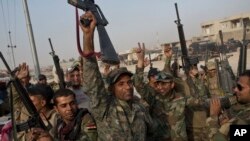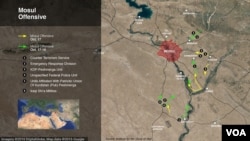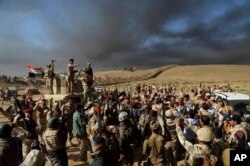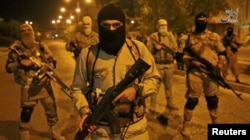Less than a week into the offensive to retake the Islamic State’s Iraqi stronghold of Mosul, the list of towns and villages freed from the terror group’s grip continues to grow while Iraqi and Kurdish commanders praise the faster-than-expected pace.
Only U.S. military and intelligence officials remain cautious, warning that the terror group has no intention of losing the Iraqi capital of its self-declared caliphate.
The only question, they say, is which Islamic State will ultimately reveal itself when the battle reaches Mosul city streets: the crafty and pragmatic terror group, or the no less brutal apocalyptic death cult.
“ISIL faces a decision point – does it hold the line in Mosul or beat a retreat?” a U.S. intelligence official told VOA, speaking on condition of anonymity.
“ISIL has in the past prioritized its own survival and in most cases fled when faced with overwhelming force,” the official said, using one of several acronyms for the group. “At the same time, Mosul is one of ISIL’s strongholds and is crucial to the group’s claim of a caliphate.”
Moderate resistance so far
For the past two years, IS has entrenched itself in Mosul, using the northern Iraqi city to bolster both its finances and its fighting forces. But U.S. military officials closely monitoring the progress of the Iraqi-led Mosul offensive say so far, IS has given few indications as to how the final battle for the city will play out.
Officials characterize IS resistance in the areas surrounding Mosul, so far, as moderate, featuring the use of artillery and sniper fire, IEDs (improvised explosive devices) and suicide bombers to slow, not stop, the advance of Iraqi and Kurdish forces.
IS fighters have also set fire to trenches and pits filled with oil and tires.
South of Mosul, IS fighters even set fire to a chemical factory, sending plumes of toxic smoke into the air, before finally retreating.
Just how many IS fighters are involved in setting up these so-called disruption zones is unclear. But U.S. officials estimate IS could have as many as 1,500 to 2,000 fighters at its disposal.
Officials say another 3,000 to 5,000 IS fighters could be waiting inside Mosul itself. Of those, some may be as young as 12 to 15 years old, sent to the city more for indoctrination and propaganda purposes than for their military value.
There are also about 1,000 foreign fighters, some sent in within the past week or so as reinforcements.
“The great unknowable is if ISIS stands and fights according to some version of its propaganda,” said Patrick Skinner, a former intelligence officer now with The Soufan Group, a provider of strategic security intelligence services.
“On some level, it's hard for a cult that preaches end-of-time battles to cut and run and fight another day,” he said “But they've been laying the ground work for exactly that for almost a year.”
In for the long haul
There are some indications IS will fight to hold Mosul as long as possible.
U.S. military officials say the group’s operational military commanders, the ones who would be directly involved in the defense of Mosul, have not yet left the city. And even with Iraqi and Kurdish forces quickly advancing from the south, north and east, there has been no sign of any attempts by those mid-level commanders or their fighters to escape to the west, to the IS-held city of Tal Afar and then, perhaps, to shrinking safe havens in Syria.
As the noose eventually tightens around Mosul, there may be nowhere to go for the 1,000 or so IS foreign fighters.
“It's likely any last stand fighting will be by its foreign fighters who have a very limited shelf life in any future past the loss of Mosul,” said The Soufan Group’s Skinner. “They barely fit in during the rule of ISIS. They will be hated and hunted afterward.”
But there are also strong indications Mosul will not be the last stand for at least the group’s most senior leaders.
Despite repeated assertions by various Iraqi officials that IS leader Abu Bakr al-Baghdadi is holed-up in Mosul, U.S. officials believe much of the senior leadership has already fled.
And even if Baghdadi is still in Mosul, his presence is unlikely to give IS any military advantage.
“I would argue Baghdadi is in no position to participate in a last stand,” said Nicholas Glavin, a senior researcher at the U.S. Naval War College's Center on Irregular Warfare and Armed Groups. “He’s the ideologue of this group and his charismatic presence is a driver of the Islamic State’s actions in and out of its core territories.”













